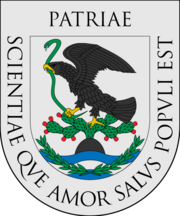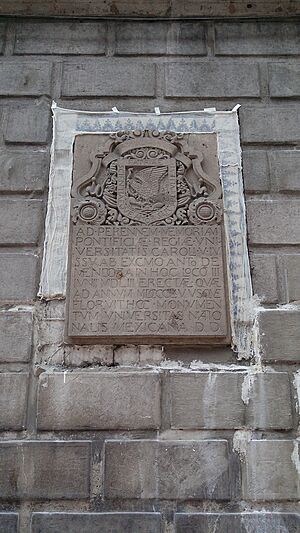Royal and Pontifical University of Mexico facts for kids
|
Real y Pontificia Universidad de México
|
|

Coat of arms of the Royal and Pontifical University of Mexico
|
|
| Motto | Patriae scientiae que amor salus populi est |
|---|---|
|
Motto in English
|
Love of the homeland and of knowledge is the health of the people |
| Active | 21 September 1551–1865 |
| Affiliation | Roman Catholic |
| Location | , |
| Campus | Urban |

The Royal and Pontifical University of Mexico (Spanish: Real y Pontificia Universidad de México) was a very important school founded a long time ago in Mexico City. It was started on September 21, 1551, by a special order from King Charles I of Spain. This makes it one of the very first universities ever created in North America. It was actually the second university in all of the Americas, just after the National University of San Marcos in Lima, Peru.
The university was called "Royal" because it was founded by the King. It was called "Pontifical" because it also had the approval of the Pope, who is the head of the Roman Catholic Church. After Mexico became independent from Spain, the university's name was shortened to simply the University of Mexico.
Contents
A University Through Changing Times
The Royal and Pontifical University of Mexico saw many changes in Mexico's history.
Closures and Reopenings
During the 1800s, Mexico had different groups of leaders. Some leaders, called liberals, believed that the government should be in charge of education, not the church. Because of this, the university, which was linked to the church, was closed down several times.
- Its first closure happened in 1833.
- However, when other leaders came back to power, the university would reopen.
The university was finally closed for good in 1865. This happened during a time when Maximilian I of Mexico was the emperor of Mexico. Even though the main university closed, some of its parts, like schools for law and medicine, continued to teach students in different ways.
What Happened Next?
Many years later, around 1910, a new public university was created in Mexico City. This was the National Autonomous University of Mexico (UNAM). UNAM is a very large and famous university today, and it is considered the modern-day successor to the original Royal and Pontifical University of Mexico. However, UNAM is controlled by the government, not the church.
Today, there is also a different school called the Pontifical University of Mexico. This university is still connected to the Catholic Church, similar to how the original "Pontifical" part of the old university was.
How the University Was Organized
The Royal and Pontifical University of Mexico had different departments, called faculties, where students could study various subjects.
Main Study Areas
The university had five main faculties:
- Theology (the study of religion)
- Canon Law (church laws)
- Medicine (how to heal people)
- Arts (which included subjects like philosophy and science)
Students would attend classes in the morning and evening. The university offered different levels of degrees, just like universities do today:
- Bachiller (like a bachelor's degree)
- Licenciado (a graduate degree)
- Maestro (a master's degree)
- Doctor (a doctorate, the highest degree)
Famous People from the University
Many important people studied or taught at the Royal and Pontifical University of Mexico.
Notable Alumni (Students)
- Bartolomé de Alva: A religious leader who translated texts into the Nahuatl language.
- Joseph A. Lopez (1779–1841): A priest who later became the president of Georgetown University in the United States.
- Agustín Dávila Padilla (1562–1604): A writer who recorded the history of the Dominican religious group and their work in the Americas.
Notable Faculty (Teachers)
- Juan José Eguiara y Eguren (died 1763): A religious leader and scholar who served as the university's rector (like a president).
- Francisco Cervantes de Salazar (around 1514–1575): A well-known writer who was rector of the university twice in its early years.
- Alonso Gutiérrez (1507–1584): A philosopher and historian from the Augustinian religious group.
- Don Carlos de Sigüenza y Góngora (1645–1700): A famous mapmaker, historian, and thinker from the late 1600s.
See also
 In Spanish: Real y Pontificia Universidad de México para niños
In Spanish: Real y Pontificia Universidad de México para niños
- List of colonial universities in Latin America
- UNAM
- Pontifical University of Mexico
Images for kids


